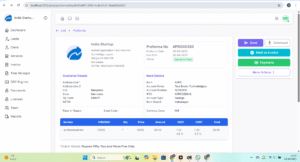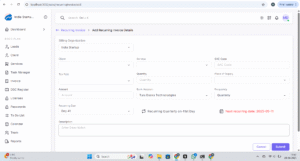📘 Understanding GST Filing in India
1. What Is GST Filing?
Goods and Services Tax (GST) is India’s destination-based, comprehensive indirect tax system launched on 1 July 2017, subsuming multiple indirect taxeslike VAT, excise duty, and service tax Wikipedia. Under GST, businesses must file regular returns—monthly, quarterly, or annually—covering sales, imports, purchases, and taxes paid/payable to the government.
2. Why Is GST Filing Important?
-
Legal Compliance: Registered businesses must file GST returns timely (e.g., GSTR‑1, GSTR‑3B). Delays lead to penalties and interest.
-
Input Tax Credit (ITC): Vendors claim ITC on eligible purchases only if both parties file accurate returns and upload invoices.
-
Business Finance & Planning: Timely and accurate GST filings help maintain proper books—key for credit access and financial clarity.
-
Credibility & Audit Readiness: Proper filings help avoid audits and enhance trustworthiness among regulators and clients.
🧾 Types of GST Returns & Frequency
-
GSTR‑1: Monthly (or quarterly, simplified for small taxpayers) summary of outward supplies.
-
GSTR‑3B: Monthly summary return of inward/outward supplies and tax payable.
-
GSTR‑9 & 9C: Annual returns; 9C includes audit certification if turnover exceeds ₹5 crore.
-
QRMP scheme: Quarterly return for suppliers with turnover below ₹5 crore; they make tax payments monthly Wikipedia.
🛠️ Step‑by‑Step Guide to Filing GST Returns
Step 1: Prepare Documents
-
Sales invoices, purchase invoices, debit/credit notes, reverse charge documents, e‑way bills, etc.
Step 2: Reconcile Input Tax Credit
-
Match invoices with supplier-uploaded data. Any mismatch must be rectified before filing.
Step 3: Choose Return & Populate Details
-
Based on turnover, choose filing type: monthly GSTR‑1 & 3B, quarterly GSTR‑1 (if under QRMP).
Step 4: File & Pay
-
File via GSTN portal using DSC or Aadhaar OTP.
-
Pay due tax using challan (CGST + SGST or IGST).
Step 5: Download Acknowledgment & File GSTR‑3B
-
Upon filing GSTR‑1, download ARN. Complete GSTR‑3B and pay residual liability.
Step 6: Validate
-
Check Liability Ledger, ITC, Refund Ledger, and Electronic Cash Ledger to ensure correct credits and payments.
Step 7: Rectify & File Annual Return
-
Amend errors via GSTR‑1 or 3B (if within allowed period). File GSTR‑9 by December next year; required audit certification (GSTR‑9C) if turnover > ₹5 cr.
💡 Common Challenges & Practical Tips
🎯 Challenges:
-
Invoice mismatches affecting ITC.
-
Complex forms and changing rules.
-
Compliance burden on small businesses.
-
E‑invoicing requirements for large turnover entities.
✅ Best Practices:
-
Use accounting software with GST compliance capabilities.
-
Start early—reconciling sooner reduces errors.
-
Download GSTR‑2B monthly for ITC reconciliation.
-
Sign up for alerts to avoid missing due dates.
-
Use the QRMP scheme if eligible—it simplifies filings.
📊 India’s GST Ecosystem: How Big Is It?
Registered GST Users
-
As of 31 May 2025, India has around 1.52 crore (15.2 million) active GST registrations Cewacor+2Dataful+2Wikipedia+2ClearTax+3Wikipedia+3Wikipedia+3WikipediaCAclubindia.
-
Breakdown:
-
~13.32 million normal taxpayers
-
~1.48 million composition scheme taxpayers
-
~0.37 million TDS deductors
-
~0.02 million TCS collectors
-
Others (ISDs, non-residents, etc.)
-
Growth Over Time
-
GST registrations doubled from ~6.78 lakh in July 2017 to 14 million by June 2023 (FM Nirmala Sitharaman) Dataful+2Hindustan Times+2CAclubindia+2CAclubindiaDataful.
-
In FY 2024–25 alone, 2.5 million+ new registrations were recorded, reaching ~15 million total in April 2025 m.economictimes.com+5angelone.in+5nsic.co.in+5.
🚀 Why the Upward Trend?
-
Expansion of informal sectors into the formal economy.
-
Government initiatives encouraging digital compliance.
-
Simplified return mechanisms such as QRMP.
-
Stronger enforcement and incentives for small businesses.
Future Outlook: Streamlining & Automation
-
E‑invoicing is mandatory for firms above certain turnover thresholds—gradually expanded since 2023 CAclubindiaCewacor+2Wikipedia+2Wikipedia+2.
-
New return system (Framework 2.0 / 3.0) is being rolled out to simplify filing.
-
GSTN upgrades to make portals faster and user-friendly.
-
AI tools in ERP to auto-populate and cross-verify data.
✍️ Putting It All Together: Filing GST Like a Pro
| Aspect | Action Steps |
|---|---|
| Invoice Management | Digitize and upload purchase invoices promptly |
| Reconciliation | Use GSTR‑2B and accounting software to reconcile |
| Return Schedule | Set calendar reminders; use QRMP if eligible |
| Compliance | Keep up with rule changes and penalty norms |
| Automation | Use ERP/GST tools to streamline filing and ITC matching |
| Professional Support | For complex audits or annual filings, consult a CA or GST practitioner |
✅ TL;DR Summary
-
GST filing is essential for compliance, ITC claims, and avoiding penalties.
-
India now boasts ~15.2 million active GST registrations as of May 2025.
-
Using technology, early reconciliation, and QRMP greatly reduces filing complexity.
-
Ongoing reforms like e‑invoicing and simplified return formats will continue improving the system.
Conclusion
GST filing may seem complicated, but with the right workflow, technology, and knowledge, it becomes manageable—even empowering—for businesses. With over 1.5 crore GST-registered users in India, the system is now a robust part of the formal economy.
By automating reconciliations, leveraging QRMP, staying updated, and planning ahead, businesses—big or small—can minimize errors, claim ITC seamlessly, and stay compliant.


